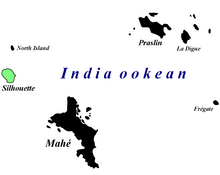
Phoenicophorium, the thief palm, is a monotypic genus of flowering plant in the family Arecaceae. The sole species is Phoenicophorium borsigianum.

The Buthidae are the largest family of scorpions, containing about 96 genera and over 1230 species as of 2021. A few very large genera are known, but a high number of species-poor or monotypic ones also exist. New taxa are being described at a rate of several new species per year. They have a [cosmopolitan] distribution throughout tropical and subtropical environments worldwide. Together with four other families, the Buthidae make up the superfamily Buthoidea. The family was established by Carl Ludwig Koch in 1837.

The Granitic Seychelles are the islands in Seychelles which lie in central position on the Seychelles Bank and are composed of granite rock. They make up the majority of the Inner Islands, which in addition include the coral islands along of the rim of the Seychelles Bank, namely Bird Island and Denis Island. The Granitic Seychelles contrast with the Coralline Seychelles or the Outer Islands, several island groups made up of low coral islands with dry, infertile soils.
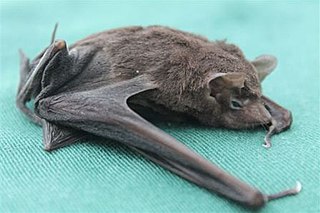
The Seychelles sheath-tailed bat is a sac-winged bat found in the central granitic islands of the Seychelles. It is an insectivorous bat, feeding primarily in forest clearings at night and roosting in communal roosts by day. Although previously abundant across the island group, it now only occurs on three islands. Its numbers have been declining to such an extent that the International Union for Conservation of Nature has listed it as being critically endangered. Increases in the cultivation of coconut palms in plantations, and the introduction of alien plant species, seem to have reduced the availability of insect food.
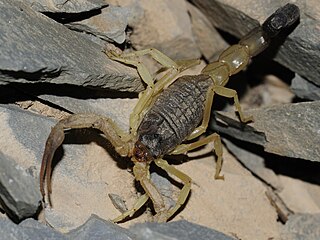
Hottentotta is a genus of scorpions of the family Buthidae. It is distributed widely across Africa, except for most of the Sahara desert. Species in the genus also occur in the Middle East, the Arabian Peninsula, southeastern Turkey, Iraq, Iran, Afghanistan, Pakistan, India, Nepal, Cape Verde Islands, and Sri Lanka (introduced).
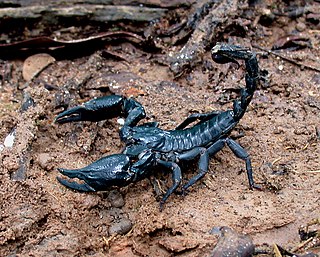
Heterometrus, whose members are also known by the collective vernacular name giant forest scorpions, is a genus of scorpions belonging to the family Scorpionidae. It is distributed widely across tropical and subtropical southeastern Asia, including Indonesia, Brunei, Malaysia, Myanmar, Philippines, Singapore, Cambodia, Laos, Thailand, Vietnam, India, and China (Hainan). It is notable for containing some of the largest living species of scorpions.
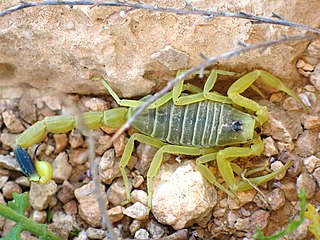
Leiurus is a genus of scorpion of the family Buthidae. The most common species, L. quinquestriatus, is also known under the common name Deathstalker. It is distributed widely across North Africa and the Middle East, including the western and southern Arabian Peninsula and southeastern Turkey. At least one species occurs in West Africa.

The tiger chameleon, also known as the Seychelles tiger chameleon, is the only species in the resurrected genus Archaius. Initially placed into Chamaeleo, it was for some time moved to the genus Calumma by some. It is an endangered species of chameleon, found only on the Seychelles islands of Mahé, Silhouette and Praslin.
Andasta benoiti is a species of ray spider that is endemic to the Seychelles. It is found on the islands of Mahé, Conception, Thérèse, North, Praslin, Marianne, Felicite and Denis. It is found in coastal woodlands. It is threatened by coastal development and habitat degradation from invasive plants, especially Cinnamomum verum.
Argyrodella is a monotypic genus of Seychelloise comb-footed spiders containing the single species, Argyrodella pusillus. It was first described by Michael I. Saaristo in 2006, and is found on the Seychelles.

Hottentotta conspersus, the Sesriem Scorpion, is a species of scorpion of the family Buthidae.

Seycellesa is a genus of spiders in the family Theridiidae. It consists of only its type species: Seycellesa braueri, which is endangered and endemic to the Seychelles.
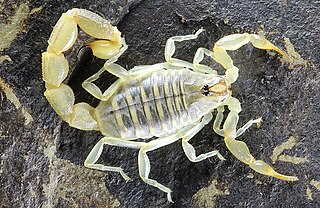
Neobuthus is a genus of scorpion of the family Buthidae. It is distributed across the Horn of Africa; in Eritrea, Ethiopia, Somaliland, Kenya and Djibouti.
Afrolychas is a genus of scorpion in the family Buthidae. There are two species in this genus, both of which used to belong to the genus Lychas. The genus was described in 2019 by František Kovařík. The genus name Afrolychas is a reference to the African range of its species and the fact that the two species used to be members of the genus Lychas. Afrolychas's closest relatives are believed to be the scorpions in the genus Pseudolychas. Afrolychas braueri is one of the rarest scorpions in the world, as it is listed as critically endangered on the IUCN Red List.
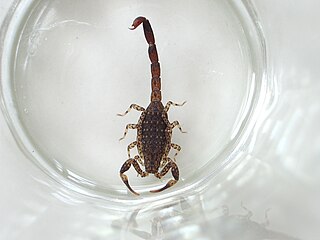
Lychas is a genus of scorpions belonging to the family Buthidae. It is one of the most widespread genus of the scorpions, where the species are found throughout in Africa and Seychelles, and in the Oriental region from India to Melanesia.
Reddyanus is a genus of buthid scorpions native to Oriental region from India, Sri Lanka, China: Tibet, to Melanesia. The genus was previously described as a subgenus of Isometrus.
Reddyanus ceylonensis is a species of scorpion in the family Buthidae endemic to Sri Lanka.
Reddyanus jayarathnei is a species of scorpion in the family Buthidae endemic to Sri Lanka.
Reddyanus ranawanai is a species of scorpion in the family Buthidae endemic to Sri Lanka.
